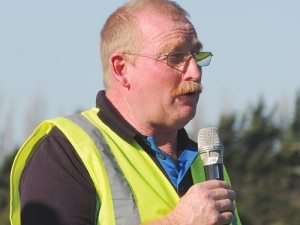Wired for Science: Understanding the feeding habits of mealybug
Fussy children might be frustrating, but fussy mealybugs could help protect the New Zealand wine industry from grapevine leafroll-associated virus 3.
 A 42-day round and fine weather’s built LUDF average cover to just over 2600kgDM/ha, according to farm manager Peter Hancox.
A 42-day round and fine weather’s built LUDF average cover to just over 2600kgDM/ha, according to farm manager Peter Hancox.
In February the management team at Lincoln University were wringing their hands as the season appeared to be turning to custard, but at the latest field day the tone was much more upbeat.
Nips and tucks rather than drastic cuts is how Lincoln University’s Dairy Farm (LUDF) is meeting the challenge of low payouts.
The high profile unit held one of its quarterly focus days earlier this month and revealed it’s on course to beat budget cash farm working expenses this season by nearly 3%. That’s despite a dry season dictating more irrigation than usual and 15% of pasture being renewed.
Milk output is back 3.3% but from 11% fewer cows with 43% less nitrogen fertiliser and 48% less imported silage.
“These are an impressive set of metrics and I have to say we’re a little bit proud of them,” Ron Pellow of the South Island Dairy Development Centre told the focus day.
“We have shown [reduced stocking rate and inputs] can be a profitable outcome, the profit, of course, being relative to what the payout is doing.”
Pellow says he’s eager to see how, come July, LUDF’s final profit will compare against the half dozen top performing Canterbury dairy farms which it has benchmarked itself against in previous years.
Expanding on the detail of LUDF’s season, farm manager Peter Hancox says production is now forecast at 272,500kgMS compared to 280,000kgMS budgeted.
Offsetting that, $5722 and $7106 has been saved on silage purchase and making, while lower use of gibberlin saved $3524 and nitrogen price cuts another $13,169.
“When we set the budget, nitrogen was about $700/t and it’s come down to the high $500s, and we’ve used slightly less,” said Hancox, reflecting on the 143kgN/ha applied.
Regrassing costs have also come in well under budget at $24,000 instead of the planned $37,000 thanks to direct drilling one of three paddocks, and a dry spring reducing damage so less over-sowing was needed.
Not employing any casual staff and delaying replacing a staff member who left late March leaves $9647 extra in the bank on budgeted employment costs of $260,000, and vehicle expenses are down nearly $11,000 from a planned $31,336 thanks to cheaper fuel, less mowing, and repairs and maintenance savings.
Insulating milk silos and upgrading refrigeration equipment has helped shave nearly $8000 off the forecast $30,200 electricity bill, irrigation excluded.
Increased irrigation owing to the dry season put all irrigation costs, electricity included, 25% over budget at $76,878 to the end of March, and with unseasonably warm, dry nor-west weather earlier this month it was possible the pumps could be back on again, the field day attendees heard.
But the biggest budget blow-out is replacement grazing and meal costs – mainly more milk powder and calf meal, taking $19,791 more than planned off the bottom line.
Animal health and breeding costs are also up on budget.
Adding it all up, farm working expenses (FWE) to the year end for the 167ha, 560-cow unit, are now forecast at $1.099m compared to $1.131m budgeted, but with production down 2.7% on budget the reduction in FWE/kgMS is just one cent, from $4.04/kgMS to $4.03/kgMS, with a cash operating surplus of $1929/ha compared to $1963/ha budgeted.
Asked whether the budget for next year would be much different, Hancox said it wouldn’t be.
Acclaimed fruit grower Dean Astill never imagined he would have achieved so much in the years since being named the first Young Horticulturist of the Year, 20 years ago.
The Ashburton-based Carrfields Group continues to show commitment to future growth and in the agricultural sector with its latest investment, the recently acquired 'Spring Farm' adjacent to State Highway 1, Winslow, just south of Ashburton.
New Zealand First leader and Foreign Affairs Minister Winston Peters has blasted Fonterra farmers shareholders for approving the sale of iconic brands to a French company.
A major feature of the Ashburton A&P Show, to be held on October 31 and November 1, will be the annual trans-Tasman Sheep Dog Trial test match, with the best heading dogs from both sides of the Tasman going head-to-head in two teams of four.
Fewer bobby calves are heading to the works this season, as more dairy farmers recognise the value of rearing calves for beef.
The key to a dairy system that generates high profit with a low emissions intensity is using low footprint feed, says Fonterra program manager on-farm excellence, Louise Cook.